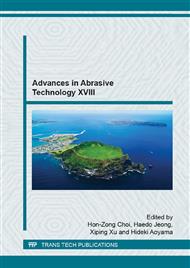p.537
p.543
p.549
p.555
p.561
p.567
p.573
p.581
p.586
Improving Tool Wear Resistance in Inconel 718 Cutting by Considering Surface Microstructures of CBN Cutting Tool
Abstract:
Nickel-based superalloys such as Inconel 718 are known as one of the most difficult-to-cut materials due to their mechanical and chemical properties and the tool life is extremely short. Recently, Cubic-Boron-Nitride (CBN) has received a considerable attention as a material for cutting tools and has been considered to be a major candidate for high performance cutting of Inconel 718. However, the detailed wear behavior of CBN tools in cutting of Inconel 718 is not sufficiently understood yet, and the performances of CBN tools are still insufficient in practical use. To overcome this problem, we first conducted orthogonal cutting experiments on Inconel 718 at low (20 m/min) and high (100 m/min) cutting speeds employing CBN cutting tools to clarify the detailed wear mechanisms. Moreover, relationship between surface microstructures of the cutting tool and wear resistance was investigated. As a result, it was found that a rake face with micro grooves significantly suppressed the crater wear at low cutting speed, although polished surface rake face reduced the initial crater wear by approximately 40 % compared to the non-polished tool in high speed cutting of Inconel 718.
Info:
Periodical:
Pages:
561-566
Citation:
Online since:
January 2016
Authors:
Keywords:
Price:
Сopyright:
© 2016 Trans Tech Publications Ltd. All Rights Reserved
Share:
Citation:


